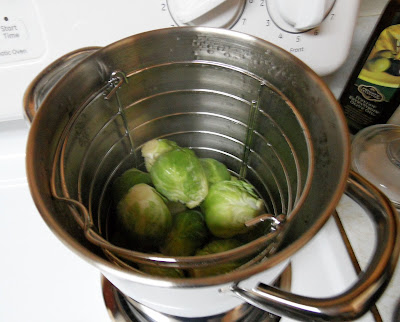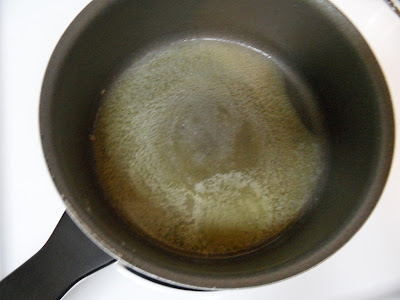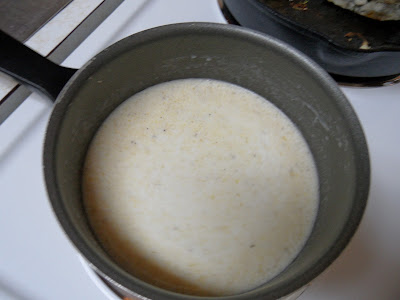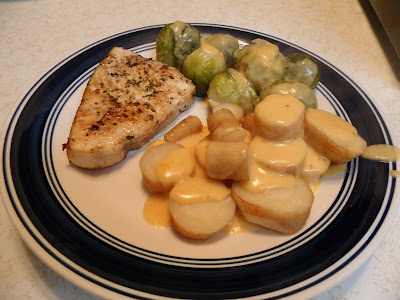 |
| Because cheese makes everything delicious. |
Let's get started!
Ingredients:
Since this is sort of a "whatever you want" sort of meal, and not really a specific recipe, there's really only a need to list ingredients for the sauce:- Butter
- Flour
- Milk
- Cheese (I used Cheddar, but pretty much any cheese that melts well will do)
Part 1: Steamed Vegetables
For this meal, I'll be steaming up some parsnips and Brussels sprouts. Now, I know what you're thinking, "eww, Brussels sprouts!" but hear me out for a sec. Once, long ago, I too thought I hated these little green things. They were extremely bitter, mushy, and just all-around unappealing. BUT! That really only happens when they're cooked incorrectly! Done right, they're actually not dissimilar from cabbage or broccoli in flavor, have a texture similar to slightly firm, yet "al-dente" cabbage, and are also super-nutritious. And botanically speaking, they're EXACTLY the same thing as the buds on broccoli, and many consider those the best part! Basically, any way you'd cook broccoli tops, would work equally well for Brussels sprouts. They're amazing when sliced in half longways and roasted or skillet-fried, for example.Anyways, now onto the actual cooking part. If you're going to be steaming different types of vegetables like I am here, put in those with longer cooking times first (namely, your root veggies). Leafy things like sprouts take far less time to steam-cook, so we'll hold off on putting them in.
The first vegetable I'm putting down is parsnips. These are closely related to carrots, but with higher starch content (in other words, more "mashable") and a sweeter taste. If you like carrots, chances are you'll enjoy parsnips as well. Rinse them, cut them into manageable chunks, then put them in the steamer.
 |
| No veggie steamer, you are not the Large Hadron Collider; go home you're drunk. |
While those are going, let's start working on our Brussels sprouts. Chop off about 1/4in of the stem, and peel off the outermost leaves (plus any that are dirty, discolored or "blotty"... if there are too many of the blotty leaves on a sprout, just discard that one and move on. It's usually an indication that that sprout either has something growing in it, or is otherwise just bad. Sprouts are cheap, so don't feel bad about tossing out two or three from the bag).
 |
| Getting rid of the yucky bits. No, that doesn't mean the whole thing. |
Once you've taken off the stems and outermost leaves, rinse the sprouts and set them aside. Brussels sprouts usually come in mesh bags that are ideal for rinsing them in!
 |
| Aren't they beautiful? No? *sigh...* |
Part 2: And now, the fish! Kind of the star of the dish...
Pretty much any kind of fish will take well to pan-frying. I personally prefer the higher-protein fish that come in larger cuts such as tuna, salmon, and of course, swordfish (as shown here). These can be treated in much the same manner as your regular beef steaks, in other words really high heat for short times; giving the outside a decent sear while not overcooking the inside. And the supreme advantage of swordfish is that, when cooked, it has a texture not too dissimilar from a really juicy, tender pork chop, but with the addition of being just flaky enough to not need a knife. And they taste incredible, to boot!When selecting swordfish filets, this is pretty much the look you're going for. Mostly a really faint pinkish white, with just a tiny bit of a magenta-like coloration (as you can see toward the bottom of this picture). Also, vacuum-sealed is pretty much the best packaging for fresh fish, if not immediately cut for you by the fish monger (who, btw, should be your best friend at the market if you're a fan of any sort of seafood).
 |
| Swordfish! The delicious food, not the awful movie... |
Let's start by melting a bit of butter in a skillet, on high heat (if you've got a range vent, use it! Butter likes to smoke). Just like with steaks, since I'm going to want this to have a tasty sear to it, cast-iron is definitely the way to go.
At the same time, put down about 1/3 stick of butter in a saucepan on low heat to get the sauce started.
 |
| Butter: a.k.a. half of what runs in Southerners' veins, along with Bourbon and/or beer. |
Part 3: Multitasking!
Since all of these are foods that this meal consist of cook fairly quickly, we're pretty much going to be in rush mode for the remainder. GOOOOOOO--!During the time it took to prepare the sprouts and heat up the skillet, the parsnips should be cooked enough to be done in about the same time it would take the sprouts to fully cook. Toss them in the steamer and let's move back to the fish.
 |
| Like a ball-pit, only with a cabbagey aroma. So... no different from normal. Huh. |
When the butter begins to separate and smoke slightly, it's time to put the fish down. For whitefish like this, I prefer a simple seasoning of lemon pepper and tarragon. That's it! Just let the fish sit on the metal for a bit, and as some of the fat renders out just cut it away with the spatula and keep going.
 |
| Don't worry, cooking swordfish doesn't stink nearly as bad as the movie did. |
Part 4: Finally, that sauce thing you were waiting for!
Once the butter in the saucepan is melted, REMOVE IT FROM THE HEAT (this is important; if you don't you may end up with little fried floury lumplets instead... which aren't nearly as good as it sounds), and start stirring in flour a tiny bit at a time, stirring it in until it's fully integrated into the butter. You'll want roughly the same amount of flour as butter. |
| Paula Deen would be proud. |
Once enough flour is added, you'll have a roux (like the base of the gravy seen in the Country Fried Stuff edition!).
 |
| Sorry for the blurriness, my camera decided to go full potato that day. |
Next, add in some salt, pepper, dry mustard powder (just a tiny bit, but it makes an awesome difference, trust me) and about half a cup of milk. The roux will tighten up at this point as it reacts to the cold milk, but don't worry, this is normal. Put it back on the heat, and cook it low until everything smooths itself out.
 |
| Eww, it's all separatey and stuff! (Only for a few minutes, don't worry) |
Part 5: The final stretch of multitaskingness!
In about the time it took to work on the sauce, you should have a decent sear on one side of your fish. Flip the pieces, season the other side of them, and keep them going. |
| Potatocamera strikes again! *shakes fist* But, you can get the idea; nice sear on the fish, etc. |
After only a couple of minutes, your sauce ingredients should be integrated and mixed quite nicely. You now have the base sauce known as a "bechamel," as mentioned in the title! This is pretty much the base of all proper creamy or cheesy sauces; gravies as well, though those are more flour and less milk. Once you have this, start adding in your cheese a bit at a time, stirring it in until it melts.
 |
| It's something! |
Also, a side-note: Back when I was writing the Blackened Chicken Alfredo edition of I Can Cooking!, I mentioned an "advanced method" for making the cheese sauce; this is pretty much exactly what I was talking about (except that one would've used bacon grease instead of butter, but the technique still stands).
Anyways, after you've added in the cheese and cooked the sauce for a bit longer after it's all melted down, it should look something like this. Nicely thick, but not stringy. Don't worry about the bit of surface oil on the sauce that's in the pan, that's just what naturally separates out from the Cheddar.
 |
| SO much better than the boxed stuff, I promise. |
Aaaaaand we're done!
With the parts done in the order I've shown, the fish, veggies, and cheese sauce should get done right about the same time! Enjoy your delicious and (mostly) healthy meal, that you've made entirely from scratch! |
| Totes delicioso. |
No comments:
Post a Comment